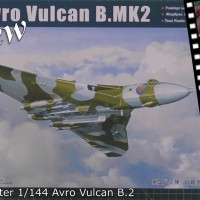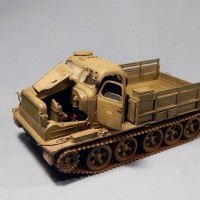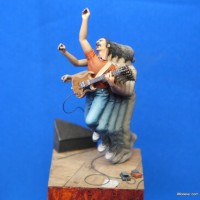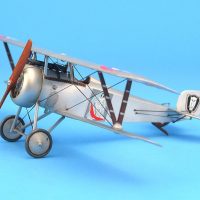RCAF Sabre Mk. 6 – Kinetic 1/32
The Kinetic 1/32 F-86F done as an early RCAF Sabre Mk. 6 (hard leading edge wing) with Harold Offield's cockpit set and Leading Edge decals (which include the resin "sugar scoops" that are the visual difference between a Sabre 6 and an F-86). When I got the first of these kits in 2007, I thought the surface detail was overdone, then I went out to Chino and looked at the two Sabres there, and it turns out this surface detail is very accurate. Believe it or not, the center box of the Sabre wing is filled with Phillips-head screws!
When the North American Sabre flew in 1947, it attracted attention throughout the West's aviation industry. In 1948, the Royal Canadian Air Force began serious planning for modernizing the equipment of their fighter squadrons. It was obvious that the best fighter available was the Sabre, and during that year the Canadian government made a decision to equip the RCAF with the Sabre. A license agreement was quickly reached with North American and Canadair became the manufacturer of the Canadian Sabre, known as the CL-13. A total of 1,815 CL-13 Sabres were built by Canadair between 1950-58.
Perhaps the best Sabre ever produced by anyone was the Sabre Mk.6, which was to the rest of the Sabres as the MiG-17 was to the MiG-15 in terms of performance. Powered by the Orenda 14 with 7,275 lbs of thrust - a 150% increase over the power of US Sabres - the Sabre Mk. 6 outperformed every fighter in its class. It had the best climb performance and altitude of any Sabre; had the Sabre Mk.6 been the opponent of the MiG-15 over the Yalu in Korea, it would have been the Soviets who would have been looking up at 50,000 feet to find Sabres diving on them. The only Sabre that really comes close to the Mk. 6 is the Australian Commonwealth-built Sabre with the Avon engine.
The first 220 Mk.6 Sabres had the 6-3 hard-edge wing of the later F-86F series. The wing slats were brought back from that point for the rest of the 655 Mk. 6s produced; this improved low-speed performance without losing high speed performance. The first Sabre Mk.6 was completed November 2, 1954. 390 Mk 6s equipped the four RCAF Sabre wings serving in France and West Germany with NATO, where the Sabre Mk. 6 was considered the best dogfighter of any fighter serving with a NATO Air Force. 225 Sabre Mk.6s were supplied to the new German Luftwaffe, beginning in 1955, where they served until replaced by the F-104G in 1964. Following their German service, Sabre Mk. 6s were transferred to the Venezuelan, Colombian, Argentine and Chilean air forces where they served for many years.
















Looks like another wonderful piece of work, Tom. A really interesting read, too. Sounds like the Canadians did the same thing to the F-86, that the Italians did to the F-104.
Looks great Tom...nice work on a beautiful aircraft.
Nicely written history, Tom, and, of course, the model looks nice too. There's definitely something attractive about this era of jet aircraft (or maybe it's just my age!).
Really good looking.
That's very nice Tom. I learned a lot from your historical information also. Nice work all around.
Gary